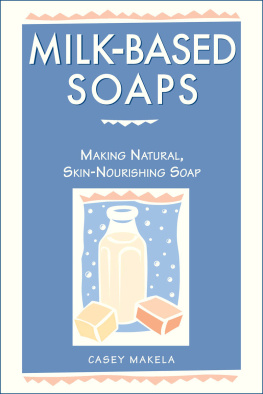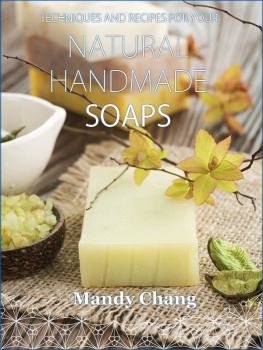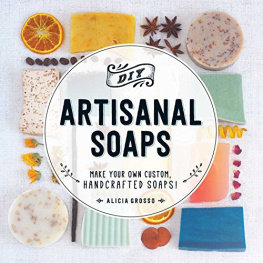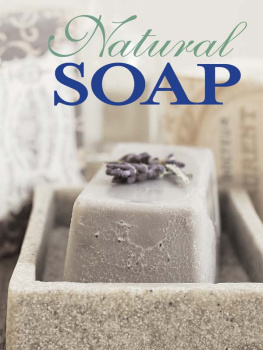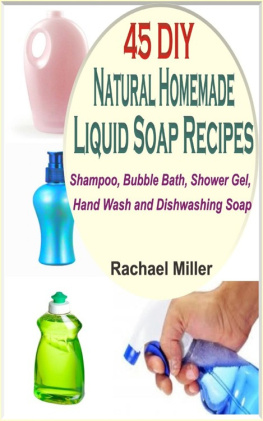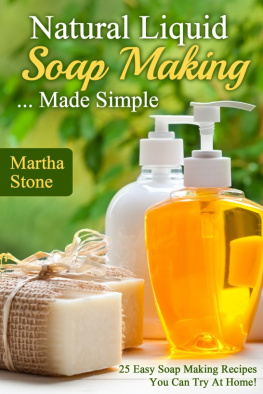making natural
liquid
Soaps


making natural
liquid
Soaps
herbal shower gels conditioning shampoos
moisturizing hand soaps luxurious bubble baths,
and more

catherine failor

Dedicated to K. D. Grace
Many thanks to the people who have given me emotional
support, offered a helping hand, and/or shed a little light:
Kay Whaley, Clyde Abston, Carla Dunn, Jim Morgan, Luis
Spitz, David Woodward, Dr. Bob McDaniel, Ray Linke,
Alan Zell, and the late Jim Bronner.
The mission of Storey Publishing is to serve our customers by
publishing practical information that encourages
personal independence in harmony with the environment.
Edited by Deborah Balmuth and Robin Catalano
Cover design by Carol Jessop, Black Trout Design
Cover and interior photographs by Giles Prett except those by
Jeff Burke and Lorraine Triolo for Artville on pages 91, 93, 94, 95, and 98;
Eyewire Images on pages vii, 32, 38, 39, 40, 53, 66, 67, 92, and 134;
PhotoDisc, Inc. on pages 48, 55, 59, 65, 76, 84, 87, 92, and 115
Text design and production by Mark Tomasi
Production assistance by Susan Bernier
Indexed by Barbara Hagerty
2000 by Catherine Failor
All rights reserved. No part of this book may be reproduced without written permission from the publisher, except by a reviewer who may quote brief passages or reproduce illustrations in a review with appropriate credits; nor may any part of this book be reproduced, stored in a retrieval system, or transmitted in any form or by any means electronic, mechanical, photocopying, recording, or other without written permission from the publisher.
The information in this book is true and complete to the best of our knowledge. All recommendations are made without guarantee on the part of the author or Storey Publishing. The author and publisher disclaim any liability in connection with the use of this information. For additional information please contact Storey Publishing, 210 MASS MoCA Way, North Adams, MA 01247.
Storey books are available for special premium and promotional uses and for customized editions. For further information, please call 1-800-793-9396.
Printed in Hong Kong by Elegance Printing
20 19 18 17 16 15 14 13 12 11 10 9
Library of Congress Cataloging-in-Publication Data
Failor, Catherine.
Making natural liquid soaps / Catherine Failor.
p. cm.
ISBN 978-1-58017-243-1 (pbk. : alk. paper)
1. Soap. I. Title
TP991.F26 2000
668.12dc21
99-057462
CIP
Preface
My love affair with soapmaking began more than twenty years ago when I stepped into a small bookstore in Eugene, Oregon. A slender, charming little book immediately caught my eye; the cover photo showed a woman carving designs into bars of soap. The book was Soap: Making It, Enjoying It, by Ann Bramson. As I stared at those bars on the cover, they seemed to me more beautiful than precious jewels. Ive been making soap ever since.
Ive often wondered just what it is about soapmaking thats held my attention for all these years. In part, its because soap is so aesthetically pleasing. I never seem to tire of making it and marveling at it. But perhaps an even bigger attraction for me is that soapmaking offers so many avenues of inquiry, discovery, and invention a seemingly endless amount!
Considering how ubiquitous soap is and what an intimate role it plays in our everyday lives, relatively little has been written about it. Compare that to cooking; gardening; or other crafts, such as sewing, jewelry making, or ceramics. Perhaps this is because soapmakers historically fell into two classes: rural women who produced true grit lye soap (which removed not only dirt and grime but the epidermis as well) and commercial soap-makers, whose soapmaking techniques became trade secrets.
Several excellent soapmaking books published over the past few years have helped turn the tide and refine the art of home soapmaking. All these books have been about cold-process soapmaking. But I always have an eye out for whats not there, which is partly a personal bent and partly a businesspersons survival reflex. And whats not there is information about hot-process soapmaking and all the soaps that can be made with that technique: transparent and translucent bars, liquids and gels, cream and floating soap, and more.
I first explored hot processing in my book Making Transparent Soap (Storey Publishing, 2000). Making Natural Liquid Soaps is a cumulation of almost two years of perspiration and further experimentation with hot-process soapmaking. Emphasis is on the perspiration because if you read any of the books listed in the bibliography, youll see just how sketchy and incomplete the information on liquid and gel soapmaking really is. What has been written is aimed at large-scale industrial soapmakers who already know the tricks of the trade. So, in addition to being an author, Ive also had to function as a translator and an interpreter: translating industrial manufacturing techniques down to kitchen scale, and interpreting what seems to lie between the lines of those old soapmaking manuals. Which is just about everything.
This book has been a methodical labor of love, but I must confess that many discoveries happened quite by accident. Im certain theres lots more out there to be learned and communicated about liquid soapmaking. I hope this book will offer a starting place for some other enterprising soul.

contents









an introduction to soap
What is soap and how does it clean?
The words soap and saponification share the same etymological ancestor: sapo
Next page

